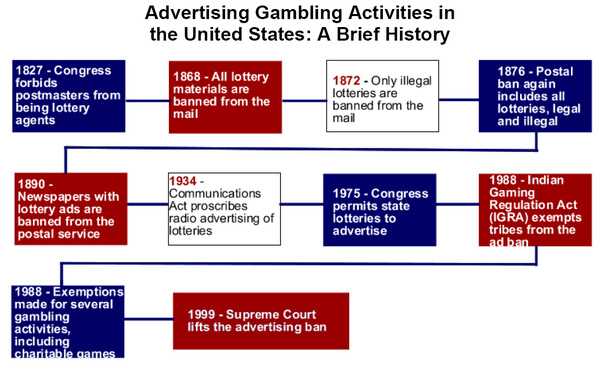The WAGER, Vol 4(24) – Judgment Day for Casino Advertising
On Monday, the United States Supreme Court struck down a longstanding ban on non-Indian casino advertising on television and radio. Overturning the ruling of the Fifth Circuit Court of Appeals, the justices found the ban to be in violation of the First Amendment right to freedom of speech. Furthermore, they held that the prohibition served no important public interest. The case before the court, Greater New Orleans Broadcasting Association, Inc., et al. v. United States et al., involved broadcasters in New Orleans who wished to air advertisements for casinos in Louisiana and Mississippi. Casino gambling is legal in both states. Previously, casinos were allowed to advertise as vacation destination but not as gambling venues. In its unanimous decision, the Court essentially struck down section 1304 of Title 18 of U.S. Code, which stipulated fines and/or up to a year in prison as a penalty for violators. The timeline below presents a brief history of related legislation and jurisprudence.
The Court’s decision was based in part on the Central Hudson test, which asks the following questions:
1.Does the speech at issue concern lawful activity? Is it misleading?
2.Is the government’s asserted interest in regulating the speech substantial?
3.Does regulation directly advance the government’s asserted interest?
4.Is the regulation in question more extensive than necessary to serve that interest?
Neither party contests the legality of gambling or the truthfulness required by the first stipulation. Concerning the second and third parts of the test, the Court held that the government did have substantial interest in regulating casino advertising. However, the failure of the government to adopt a unified, coherent policy on gambling undermines this interest. Furthermore, no justification was found for the status quo of permitting tribal advertising of casinos while prohibiting advertising by non-Indian parties.
How will the commencement of casino advertising affect the prevalence of gambling, both pathological and non-pathological? Since such advertising has been illegal since the advent of radio and television, we have no history on which to base an inference. It is likely that Monday’s Supreme Court decision will not quell the controversy surrounding this issue. As is the case with tobacco and alcohol advertising, certain issues may arise: How will Madison Avenue portray gambling venues? Might casino advertising target underage gamblers or other minority populations? Could seeing ads trigger relapses in recovering gamblers? What responsibility, if any, should advertisers and advertising bear? Who will become the celebrity spokesperson par excellence for the new promotional campaigns?
Table source: Crigler, J., King J.W., & Brown, A.L. (1999). Why sparky can’t bark- A study on the ban on broadcast advertising for lotteries. CommLaw Conspectus, 2, 43.
Source: Greater New Orleans Broadcasting Association, Inc., et al. v. United States et al., 149 F.3d 334 reversed (1999-syllabus).
The WAGER is a public education project of the Division on Addictions at Harvard Medical School. It is funded, in part, by the Massachusetts Council on Compulsive Gambling, the Andrews Foundation, and the National Center for Responsible Gaming.